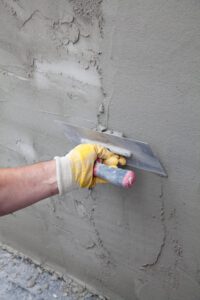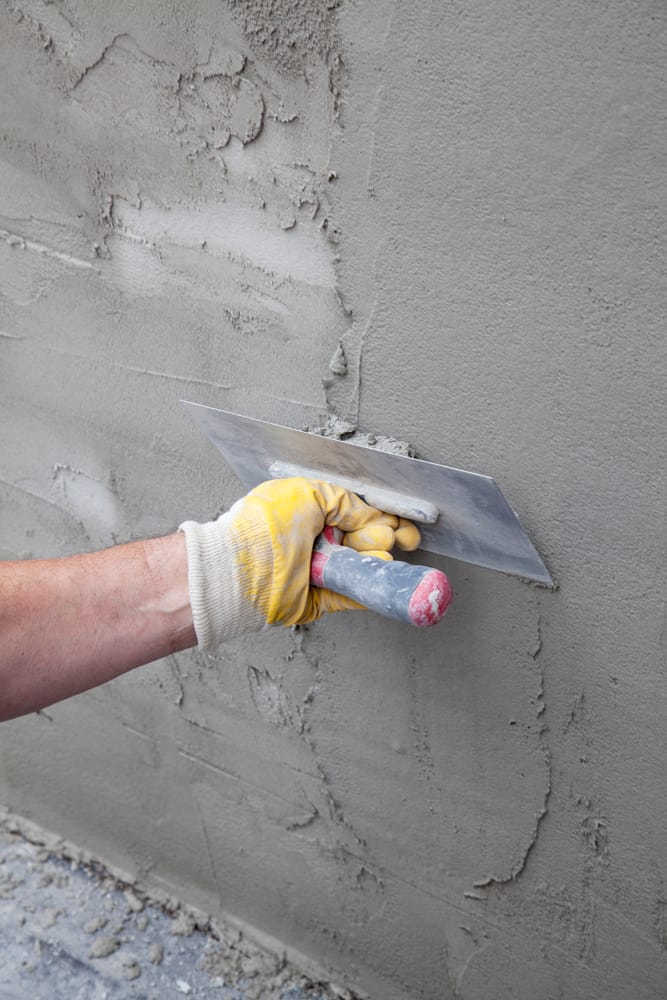Stucco Repair Philadelphia is a task that many do-it-yourselfers can tackle. However, the first step is to find the underlying problem that’s causing the deterioration and correct it before you attempt any patching.
Before starting, cover any areas you don’t want to get plaster dust on with a tarp or plastic sheeting. Next, use a hammer and chisel to break away loose stucco until you reach the wire mesh lathing.
Stucco is a very durable material, but it can crack and deteriorate over time. The good news is that cracking is a normal part of the lifespan of stucco and can be repaired fairly easily. It is important to make repairs right away to prevent the cracks from enlarging.
Ideally, you should work on the stucco repair during dry weather to avoid moisture problems. Before you start the actual repair process, clean out the cracks of debris, dirt, and dust. Then, use a putty knife to chip out any loose pieces of stucco from the surface. You should wear safety glasses and breathing protection for this process.
Once the cracks are cleaned, you can apply a sand-textured acrylic caulk to repair them. Be sure to follow the manufacturer’s instructions on the product. Once the caulk is applied, press coarse sand or gravel into the wet caulk. This will provide extra strength to the crack and help it stay fixed in place. You should let the caulk cure before you paint it.
If the cracks are very wide or if you have holes in your stucco, it is best to call in a professional. They can assess the situation, determine why the stucco cracked, and help prevent it from happening again in the future, perhaps by adding expansion joints or a weep screed. They can also re-mix fresh stucco and match the color and texture of your existing stucco to the new patchwork.
If the cracks are in a vee shape, it is recommended that you fill the upper portion of the vee with caulk. This will ensure that the cracks do not reopen in the future. It is important to note that the sealant should not be pressed into the crack itself, as this will just act as a wedge and pull the stucco apart. If the cracks are a result of the foundation shifting, it is best to consult a structural engineer to determine the extent of the damage and the repair required. A professional will also be able to help you determine whether or not the foundation should be replaced.
Holes
Stucco is a popular choice for exterior home coverings. Its durability, longevity, and striking aesthetic make it an appealing choice for many homeowners. Unfortunately, like any siding material, stucco can be subject to a variety of damage that can result in cracks and holes. The good news is that repairing these issues is usually fairly simple and can be completed by the homeowner without professional help.
Holes in stucco are typically caused by impacts from weather or other sources, such as birds or rodents. If not repaired, they can lead to moisture and insects finding their way into the wall, which can cause more serious damage.
For larger holes, the first step is to clear away loose pieces of the damaged area using a wire brush. It is also a good idea to clean some undamaged areas surrounding the hole to ensure that any patch materials will adhere to a solid surface.
Once the hole has been cleared, it is a good idea to apply a primer to the area so that the patch materials will adhere properly. After the primer has been applied, wait for it to dry before applying a second coat. For this layer, it is important to keep the wet stucco temperature around 40 degrees.
After the second coat has been applied and allowed to cure for two days, it is time to apply the final layer of new stucco. When this is done, it is important to ensure that the stippled and rough texture of the stucco matches the rest of the existing finish.
If you are not comfortable applying a fresh coat of stucco, it is possible to have a custom color match made at a local paint store. This will provide a more seamless repair and ensure that the new finish will blend in with the existing stucco. Once the new stucco has been applied and cured, it is a good idea to wait a week before painting. This will give the stucco a chance to settle properly and prevent any cracking that may occur in the future.
Water Damage
Water damage to stucco is one of the biggest problems homeowners face when they have this material on their home. Not only is it unsightly, but it can lead to further problems with the structure of the home if left untreated. There are many telltale signs of water damage in stucco, including staining, blistering, and cracks. If you notice any of these issues, then you should contact a professional right away to get them repaired.
Staining is the first sign of a moisture issue in stucco. It appears as white, hazy streaks or dark blotches on the stucco. It may also appear as bubbles or craters in the stucco. This occurs when moisture seeps into the wall and then reacts with the salt in the concrete. This reaction causes the surface to flake and peel. Staining can be spotted by a visual inspection or with a moisture meter.
Another indicator of moisture damage in stucco is if it remains wet after it rains. This can happen at a particular spot on the wall or in areas that are frequently exposed to water. A professional can take a moisture reading with a meter to find out the source of the problem and recommend a solution.
If the water intrusion is not stopped soon, it can cause major structural problems with the walls and even the foundation of the home. Moisture can also cause mold to grow. This is visible both inside and outside of the home as a green or black mold coating on the surface of the stucco. It can also be found in the drywall and insulation of the house.
To fix the moisture problem, a stucco specialist can replace any damaged materials and reseal. They can use a pre-mixed stucco repair mix, or they can mix it themselves following the manufacturer’s instructions. They can also use an acrylic bonding agent to ensure the repair is strong and long-lasting. In the case of major leaks, the contractor will have to remove the existing weather barrier and then replace it with a premium product.
Mold
Stucco can take quite a beating from the elements. In some cases, it can be ruined by serious water damage that leads to mold or wood rot underneath the stucco surface. In these cases, the stucco needs to be removed and replaced. This is a job that is typically better left in the hands of a professional.
In other cases, a small amount of mold on a stucco surface can be remedied by cleaning the surface and using a stain removal mixture. The mixture is available at most home improvement centers. If the mold is more extensive, however, a complete replacement of the stucco may be necessary.
The first step is to determine the cause of the problem. If the stucco is loose, it will bulge and feel spongey to the touch. Tap gently with a wooden or acrylic hammer to check for sound; hollow spots will give a dull, hollow sound, while intact stucco will respond with a solid sound.
Look carefully at the stained areas to see what the problem is. Black stains are usually mildew, while green stains are algae. These organisms can grow quickly, especially in warm and humid conditions. If left untreated, they can damage or weaken the exterior of the stucco, as well as penetrate and infiltrate wall cavities and framing, causing further deterioration and creating ideal growing conditions for unwanted mold, mildew, and other microorganisms.
Once you have determined what the cause of the problem is, you can move on to repairing it. Using a power washer, wash the area of the stucco where the mold stains are located. This will help to remove the mold spores and also clean the surrounding stucco and walls. Use caution while washing, and be sure to direct the nozzle of the power washer away from people, pets, or plants. Once the area has been thoroughly washed, the stucco and wall can be patched with a stucco repair mix. You can purchase a pre-mixed stucco repair mix that is ready to trowel on or a conventional stucco repair mix that will need to be mixed in a wheelbarrow or plastic tray following the manufacturer’s instructions.

